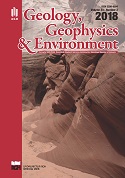The leaching of mineral nitrogen forms from light soil fertilized with compost and sewage sludge
DOI:
https://doi.org/10.7494/geol.2018.44.3.319Keywords:
mineral nitrogen, light soil, sewage sludge and compostAbstract
The research was carried out in the years 2003-2013 in lysimeters filled with loamy sand. The leachate was tested in three variants: Z - no fertilization, S - 20 g-m-2 of N delivered annually in sewage sludge and C - 20 g-m-2 of N in the form of compost. The lysimeters were planted with Miscanthus giganteus, which is an energy plant with a high demand for water and nutrients. The amount of leaching of mineral nitrogen forms was determined on the basis of measured volumes of leachates from the soil and volumes of ammonium nitrogen (N-NH4) and nitrate nitrogen (N-NO3) contained in them. The research results showed a significant increase in the average content of mineral nitrogen forms in the effluents from the fertilized soil (S - 6.8 mg-dm-3 of N-NO3 and 0.3 mg-dm-3 of N-NH4, C - 7.8 mg-dm-3 of N-NO3 and 0.4 mg-dm-3 of N-NH4), compared to their concentrations in the leachates from non-fertilized soil (Z - 2.1 mg-dm-3 of N-NO3 and 0.2 mg-dm-3 of N-NH4). The content of mineral forms of nitrogen, in particular N-NO3, were similar in both fertilization variants. The lowest concentrations of mineral nitrogen in the leachates occurred in the third and fourth year after planting Miscanthus giganteus, when it entered the period of the highest yield. In the fifth year, due to a cold, snowless winter, there was a weakened growth of plants, which resulted in an increase in the concentration of mineral nitrogen in the leachates from the fertilized soil. It follows that in addition to the intensity of precipitation, the collection of this component by plants primarily influences nitrogen leaching from the soil. The general amount of mineral nitrogen leached from the soil was not large and amounted Z - 2.5 kg-m-2, S - 6.7 kg-m-2, C - 6.4 kg-m-2. This testifies to the intense collection of this form of nitrogen by Miscanthus giganteus.
Downloads
References
A set of standards, 1999. Water and sewage. Alfa-Vera, Warszawa.
Czuba R. (red.), 1986. Nawożenie. Wyd. 2. PWRiL, Warszawa.
Czyżyk F. & Kozdraś M., 2004. Właściwości chemiczne i kompostowanie osadów z wiejskich oczyszczalni ścieków. Woda-Środowisko-Obszary Wiejskie, 4, 2a (11), 559-569.
Czyżyk F. & Kozdraś M., 2008. Azot i fosfor w odciekach z gleby lekkiej nawożonej kompostem z osadów ściekowych. Zeszyty Problemowe Postępów Nauk Rolniczych, 526, 311-317.
Czyżyk F. & Rajmund A., 2014. Influence of agricultural utilization of sludge and compost from rural wasterwoter treatment plant on nitrogen passes in light soil. Polish Journal of Chemical Technology, 16, 1, 1-6.
Czyżyk F., Pulikowski K., Strzelczyk M. & Pawęska K., 2011. Wymywanie mineralnych form azotu z gleby lekkiej nawożonej corocznie kompostem z osadów ściekowych i nawozami mineralnymi. Woda-Środowisko-Obszary Wiejskie, 11, 4 (36), 95-105.
Fotyma E., 1996. Zastosowanie metody Nmin do oceny środowiskowych skutków nawożenia azotem. Zeszyty Problemowe Postępu Nauk Rolniczych, 440, 89-99.
Gondek K. & Kopeć M., 2008. Wpływ nawożenia na wymywanie wybranych składników pokarmowych roślin w doświadczeniu wazonowym. Acta Agrophysica, 12 (1), 79-89.
Gorlach E. & Mazur T., 2002. Chemia rolna. Wydawnictwo Naukowe PWN, Warszawa.
Gotkiewicz J., 1996. Uwalnianie i przemiany azotu mineralnego w glebach hydrogenicznych. Zeszyty Problemowe Postępu Nauk Rolniczych, 440, 121-129.
Hermanowicz W., Dożańska W., Dojlido J., Koziorowska B. & Żerba J., 1999. Fizyczno-chemiczne badania wody i ścieków. Arkady, Warszawa.
Kozdraś M. & Czyżyk F., 2006. Odpływ azotanów z gleby lekkiej nawożonej kompostem z wiejskich osadów ściekowych. Zeszyty Problemowe Postępu Nauk Rolniczych, 513, 235-241.
Kozdraś M., 2006. Wykorzystanie azotu i fosforu przez kukurydzę nawożoną kompostem z osadów ściekowych. Woda-Środowisko-Obszary Wiejskie, 6, 1 (16), 221-228.
Krzywy-Gawrońska E., 2006. Zmiany zawartości azotu ogólnego, azotanowego i amonowego w masie kompostów z komunalnego osadu ściekowego i wycierki ziemniaczanej podczas rozkładu. Zeszyty Problemowe Postępu Nauk Rolniczych, 513, 243-249.
Kucharzewski A. & Nowak L., 2008. Monitoring zawartości azotu mineralnego w glebach ornych Dolnego Śląska. Zeszyty Problemowe Postępu Nauk Rolniczych, 526, 405-414.
Obwieszczenie Marszałka Sejmu Rzeczypospolitej Polskiej z dnia 9 marca 2017 r. w sprawie ogłoszenia jednolitego tekstu ustawy o nawozach i nawożeniu. Dz.U. 2017, poz. 668, [on-line:] http://prawo.sejm.gov.pl/isap.nsf/DocDe- tails.xsp?id=WDU20170000668 [access: 01.03.2018].
Pulikowski K., Czyżyk F., Pawęska K. & Strzelczyk M., 2012. Udział azotu azotanowego w ogólnej zawartości azotu w wodach odpływających ze zlewni użytkowanych rolniczo. Infrastruktura i Ekologia Terenów Wiejskich, 3/1/2012, 155-165.
Rozporządzenie Ministra Środowiska z dnia 23 lipca 2008 r. w sprawie kryteriów i sposobu oceny stanu wód podziemnych. Dz.U. nr 143, poz. 896, [on-line:] http://prawo.sejm. gov.pl/isap.nsf/DocDetails.xsp?id=WDU20081430896 [access: 01.03.2018].
Rudzianskaite A. & Miseviciene S., 2005. Nitrate nitro gen leaching in different agroecosystems (in karst zone and Middle Lithuania). Journal of Water and Land Development, 9, 123-133.
Sapek B., 1996. Potencjalne wymycie azotanów na tle dynamiki mineralizacji azotu w glebach użytków zielonych. Zeszyty Problemowe Postępu Nauk Rolniczych, 440, 331-341.
Sapek B., 2010. Uwalnianie azotu i fosforu z materii organicznej gleby. Woda-Środowisko-Obszary Wiejskie, 10, 3 (31), 229-256.
Sądej W., Bowszys T. & Namiotko A., 2009. Leaching of nitrogen forms from soil fertilized with sewage sludge. Ecological Chemistry and Engineering A, 16, 8, 1001-1008.
Scholefield D., Lockyer D.R., Whitehead D.C. & Tyson K.C., 1991. A model to predict transformations and losses of nitrogen in UK pastures grazed by beef cattle. Plant and Soil, 132, 2, 165-171.
Sojka M., Murat-Błażejewska S. & Kanclerz J., 2008. Wymywanie związków azotu i fosforu ze zlewni rolniczej w zróżnicowanych okresach hydrometeorologicznych. Zeszyty Problemowe Postępu Nauk Rolniczych, 526, 443-450.
Downloads
Published
Issue
Section
License
Authors have full copyright and property rights to their work. Their copyrights to store the work, duplicate it in printing (as well as in the form of a digital CD recording), to make it available in the digital form, on the Internet and putting into circulation multiplied copies of the work worldwide are unlimited.
The content of the journal is freely available according to the Creative Commons License Attribution 4.0 International (CC BY 4.0)










